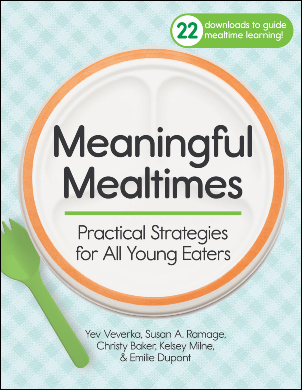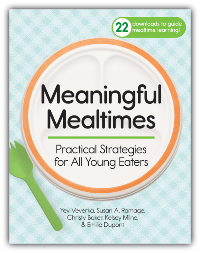6 Qualities of Meaningful Mealtimes for Young Children
November 21, 2024
 Mealtimes in early learning settings are about more than just eating. They present rich opportunities for connection, learning, and positive food experiences. The new guidebook Meaningful Mealtimes shows early childhood educators and care providers how to make the most of mealtimes—and prevent and address common feeding challenges.
Mealtimes in early learning settings are about more than just eating. They present rich opportunities for connection, learning, and positive food experiences. The new guidebook Meaningful Mealtimes shows early childhood educators and care providers how to make the most of mealtimes—and prevent and address common feeding challenges.
As the authors of the book state, their objective is to share information that will help “establish a strong foundation for learning about food, developing autonomy and trust for one’s own body cues, guiding eating that supports health and well-being, building connections, and fostering enjoyable mealtimes.” The ultimate goal is meaningful, fulfilling mealtimes—not just for young children, but also across the lifespan. To meet this overarching goal, early childhood professionals should focus on the six qualities outlined in today’s post: safety, autonomy, connection, nourishment, interest, and inclusion.
Safety
People feel calm, safe, and supported during mealtimes because they know that support is available and their needs (physical, emotional, and social) will be met. A sense of felt safety is based on what is felt within the body, the environment, and connections made with others. This sense of safety and support frees attention to focus on food, people, and new learning during mealtimes. On a larger group level, the physical safety of all mealtime participants is paramount.
Autonomy
People develop awareness and knowledge of their own body’s cues and reactions to the mealtime experience. They learn to trust these cues and develop confidence in making choices and communicating their experience and needs to others.
Connection
People feel an authentic sense of connection to those who share mealtimes with them. This includes attentive listening and responsive interactions between children and their caregivers, as well as opportunities to connect with family, friends, and community through food and mealtime experiences.
Nourishment
People learn to eat independently or with support from those around them, in a way that sustains the health of their individual bodies across their lifespan.
Interest
People discover intrinsic fulfillment and satisfaction in the mealtime experience. This might be reflected in curiosity or pleasure in exploring or cooking new foods; satisfaction in meeting the needs of one’s body; joy in relationships and identity linked to food and mealtimes; or other individual interpretations. Caregivers and providers work to foster children’s interest in mealtime activities.
Inclusion
People learn about and develop an appreciation for the way that food and mealtimes reflect diverse bodies, families, cultures, and philosophies within the world. People feel that there is space for them at mealtime to participate fully and authentically, bringing their whole self to the experience, and engaging in a way that is meaningful to them.
Individual Interpretation of Qualities of Fulfilling Mealtimes
These six qualities are not an absolute definition of meaningful mealtimes. As you think and work toward the mealtimes you hope for, you may find that your own definition of a “meaningful mealtime” includes experiences and characteristics that are different from these six, or that some qualities feel more important within your community than others. The book behind today’s blog post will guide you through self-reflection and gathering information from your communities and the children you serve to support you in developing your own vision of the mealtimes you are working toward.





Write a Comment
Your email address will not be published. Required fields are marked *
Post a Comment